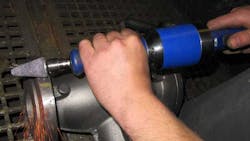Most metalcasting operations probably don’t devote much time or capital to optimizing their grinding processes, so it’s fortunate that someone has taken a fresh look to understand what can be done to make grinding more cost-efficient and effective.
Grinding is widely used, to finish or clean molds and, of course to remove sprues from finished castings. Its used in other industrial operations too, for rough machining or tool and jig construction, as well as in fabricating and construction, even in automaking, for the sorts of “geometrically undetermined” machining needed to prepare or finish a surface. Every grinding process is based on two factors — the grinder and the abrasive — and they must be carefully matched to achieve an optimal result.
Dr. Michal Hubálek, who heads product development for the Deprag Industrial family of pneumatic tools, explained that the relationship between the grinding tool and the abrasive is particularly important for efficient and ergonomic grinding operations. Getting the right balance can result in significant time and cost savings in many applications.
“Our customer, a well-known manufacturer of cast iron pump housings, requested that we re-examine their working procedures to find out where they might optimize,” Dr. Hubálek recalled. “First of all we analyzed the current situation on site. It was important not only to inspect the grinder but also the abrasive used in the customer’s application.”
The customer had been able to reach a maximum grinding speed of 32 mps. Upon closer inspection of the technical details, the Deprag techs discovered that an abrasive was being used that allowed a maximum speed of just 15,000 rpm. To process cast iron parts the pump manufacturer had opted for a straight grinder with a Deprag GDS100-190BX vane motor. The grinder’s 1-kW power output and 19,000-rpm idle speed had been the right choice for the previously used abrasive.
After the inspection, however, Deprag’s technicians undertook a deeper analysis. “Our goal is to increase productivity,” according to Hubálek. “This is basically attained by increasing the grinding speed. For optimal processing of the cast iron parts we selected the straight-design grinder, GDST100-280 BX with power output 1 kW and idle speed 28,000 rpm for the customer,” he continued.
In order for the turbine grinder to be effective a suitable abrasive is required too, one that is compatible with the higher grinding speeds. The application technicians at Deprag recommended an abrasive capable of speeds up to 29,800 rpm, almost double the speed of the abrasive previously in use.
“However our customer was not well pleased when he first heard the cost of this higher-quality abrasive,” Hubálek recalled. “It seemed to him that the unit costs were much too high compared to the previously used cheaper abrasive.
“But, it is not as simple as that,” he continued. “Whether a solution is economically viable is proven in field tests. This field test was carried out with the turbine grinder and alternative abrasive on site.”
A grinding speed of 47 mps was achieved using the new turbine grinder, 46% faster than previously achieved in this application. More than that, “this field test proved that the change to a turbine grinder not only saved processing time but also that the new abrasive lasts four times longer. The customer had not initially evaluated the increased lifespan of the abrasive,” Hubálek explained.
He related these facts in comparison to the customer’s current operations. Working in two shifts and processing 1,500 cast iron parts per week, the previous grinding routine was incapable of maintaining sufficient throughput without resorting to overtime. “But, due to the faster processing of the GDST100-280BX turbine grinder, and corresponding abrasive, so much time is saved that overtime is no longer necessary,” he reported. “Together with the four times longer service life of the abrasive, the cost comparison shows a total savings of over 30%.”
Having acknowledged (and appreciated the cost savings), the customer wanted to know what other advantages might be gained. “There is also oil-free and almost maintenance-free operation,” according to Hubálek. “Grinders with vane motors must have their vanes changed regularly but this is no longer necessary with turbine drives.”
The turbine grinder design includes wear-free magnetic brakes, which reportedly increases the run time of the grinding tool by over 30%. Also, an integrated speed regulator reduces the air consumption, depending upon the load.
Other advantages from the 1-kW output GDST100-280 BX are a lightweight body and low-noise level (75 db(A)), both of which contribute to long service life even for industrial applications that require continuous use.
“Applications like the cast iron housing, are not unusual,” according to Hubálek. “We often deal with similar situations.”
About the Author
Robert Brooks
Content Director
Robert Brooks has been a business-to-business reporter, writer, editor, and columnist for more than 20 years, specializing in the primary metal and basic manufacturing industries. His work has covered a wide range of topics, including process technology, resource development, material selection, product design, workforce development, and industrial market strategies, among others.

